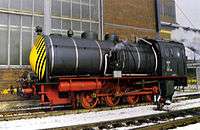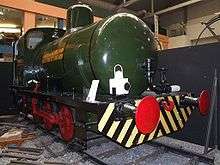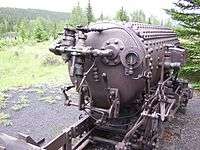Fireless locomotive

A fireless locomotive is a type of locomotive which uses reciprocating engines powered from a reservoir of compressed air or steam, which is filled at intervals from an external source. They offer advantages over conventional steam locomotives of lower cost per unit, cleanliness, and decreased risk from fire or boiler explosion; these are counterbalanced by the need for a source to refill the locomotive, and by the limited range afforded by the reservoir.
Typical usage was in industrial switching where a conventional locomotive was too noxious or risky, such as in a mine or a food or chemical factory; they also saw use where the source of air or steam was readily available.
They were eventually displaced by Diesel and battery electric locomotives fitted with protective appliances; these are described as Flame-proof locomotives.[1]
History
An early application of the fireless locomotive was to street tramways in the USA. Emile Lamm developed two types of fireless locomotive,[2][3] one using ammonia and the other using stored steam.[4] Lamm founded two companies, Ammonia & Thermo-Specific Propelling Company of America in 1872 and (with Sylvester L. Langdon) Lamm Fireless Engine Company in 1874.[5] Lamm's fireless engines were briefly popular, both in the USA and in France, but were soon displaced by electric trams. The French locomotives were built in association with Leon Francq, under the name Lamm & Francq.
The fireless system then gained a new lease of life for industrial shunting locomotives. Any factory which possessed a stationary boiler could use it to charge a fireless steam locomotive for internal shunting operations. Fireless shunting locomotives became especially popular in Germany and some remained in service into the 1960s. Fireless industrial shunters were usually of the 0-4-0 or 0-6-0 wheel arrangement but some 0-8-0s were built, by companies including Heisler. Pennsylvania Power and Light "D", in the gallery below, is an example of an 0-8-0 fireless Heisler locomotive.[6]
The Swiss company, DLM, was recently (2012) trying to promote the fireless steam locomotive as an environmentally-friendly alternative to the diesel locomotive for shunting. DLM claims that diesel shunters typically spend 75% of their working time with the engine idling.[7]
Motive power types
Steam
A fireless steam locomotive is similar to a conventional steam locomotive, but has a reservoir, known as a steam accumulator, instead of a boiler. This reservoir is charged with superheated water under pressure from a stationary boiler. The engine works like a conventional steam engine using the high pressure steam above the water in the accumulator. As the steam is used and pressure drops, the superheated water boils, replacing the used steam. The locomotive can work like this until the pressure has dropped to a minimum useful level or the water runs out, after which it must be recharged.
European fireless steam locomotives usually have the cylinders at the back, while American ones often have the cylinders at the front, as in a conventional locomotive. Major builders of fireless steam locomotives in the UK included Andrew Barclay and W.G. Bagnall.
Compressed air
Compressed air locomotives have been used for many years, mainly in mines,[8] but have also been used on tramways. (See Mekarski system)
Hybrid
Several hybrid locomotives have been built that have either used a fire for part of the time, e.g., Fowler's Ghost of London's Metropolitan in 1861, or have used a fire to superheat stored steam, such as the Receiver Locomotives built by Sentinel Waggon Works. None has been a success.
Wheel arrangements
Most fireless locomotives have been of 0-4-0 or 0-6-0 wheel arrangement but there have been some 0-8-0 and even a few 0-10-0. Some 600 mm (1 ft 11 5⁄8 in) gauge 0-10-0 fireless locomotives from the German company Henschel were used in the construction of the Baghdad Railway, probably to avoid the risk of carbon monoxide poisoning during the boring of tunnels.[9]
Another German company, Hohenzollern, built some articulated fireless steam locomotives with a cab at each end. Only one of the bogies was powered, making the wheel arrangement B-2.
Current use
Steam traction became obsolete in the 1940s and was largely replaced by diesel or electric traction. However, fireless steam has its merits, especially where there is an abundant cheap source of steam, such as in industrial sites, at thermal power stations or refuse incineration plants, where fireless steam locomotives are used for shunting at very low cost.
As they do not emit any exhaust except steam, they can shunt into buildings without endangering the workforce with noxious fumes.
Considering that shunting locomotives are typically working for only about 10% of the time, 90% waiting for work; a diesel locomotive, idling most of the time, burns too much fuel producing nothing.[10] A well insulated modern steam accumulator can preserve pressure over many hours. Thus the operating cost of a fireless steam shunter can be far less than that of a comparable diesel.
Fireless locomotives are also safer to operate than conventional steam locomotives, aside from the elimination of ignition hazards. The primary cause of a locomotive boiler explosion is the depletion of boiler water, through inattention or excessive use, exposing the crown sheet directly to the flames of the firebox, weakening it to the point of failure. A fireless locomotive eliminates this danger—if it runs out of sufficient water, it simply ceases to move—although precautions must be taken as with any other pressure vessel. Furthermore, they did not require careful monitoring of water levels and boiler pressure, nor careful distribution of coal in the firebox for efficient combustion, and thus could be operated by less-skilled staff, not requiring a fully qualified locomotive engineer and fireman.
Germany
Several locomotive builders produced fireless engines throughout the 20th century. Meiningen Steam Locomotive Works was still building them in the 1980s. Some fireless locomotives are in daily use even in 2016. One example is the large coal-fired power station in Mannheim where coal is delivered by rail in long trains of self-discharging hopper wagons. Three fireless engines are used to shunt the hoppers on the premises of the power station.
East Germany, preferring to use its abundant supply of lignite to imported fuel, used fireless engines extensively. A series of 200 fireless locomotives was built at Raw Meiningen as late as the 1980s.
Switzerland
Switzerland had used older fireless engines in industry, such a breweries. In 2010, the steam company Dampflokomotiv- und Maschinenfabrik DLM refurbished two locomotives of the German Meiningen type and modernised them for use on sidings. [11]
Preservation
Numerous examples have been preserved across the world.
Germany
The German Wikipedia has a list of steam accumulator locomotives preserved in that country. It includes over 100 preserved fireless engines, 8 of them operational.[12]
South Africa
The Electricity Supply Commission of South Africa (ESKOM) has preserved two fireless steam locomotives. They are Bagnall 0-6-0F no. 2571 of 1937 and Hawthorne Leslie 0-4-0F no. 3858 of 1935.[13]
United Kingdom
One notable example is "Lord Ashfield" (Andrew Barclay works no. 1989 of 1930) at the Museum of Science and Industry in Manchester. It ran in limited service in the 1990s sharing a steam supply with the stationary exhibits.[14]
The Ayrshire Railway Preservation Group has rebuilt its Andrew Barclay 0-4-0 fireless locomotive (Works Number 1952 of 1928) and intends to operate it as part of a demonstration freight train. The engine is due to start running on Sunday, 5 July 2015.[15]
United States
The North Carolina Transportation Museum in Spencer has a fireless steam locomotive, the North Carolina Power and Light #3 0-4-0.
Three National Cash Register 0-4-0 fireless switchers have been preserved: one at Carillon Historical Park in Dayton, Ohio,[16][17] one at the Southeastern Railway Museum in Duluth, Georgia,[18] and one at the National Museum of Transportation in Kirkwood, Missouri.[19]
Pennsylvania Power and Light "D", an 0-8-0 switcher, is preserved in the Railroad Museum of Pennsylvania.
Union Electric Company 4, a 0-4-0 is preserved in the Illinois Railway Museum of Union Illinois.[20]
Cleveland Electric Illuminating Company, an 0-6-0 built by the H.K. Porter Company, is preserved in the Mad River and NKP Railroad Museum in Bellevue, Ohio[21]
| preserved fireless locomotives | ||||||||||||||
|---|---|---|---|---|---|---|---|---|---|---|---|---|---|---|
|
See also
- Advanced steam technology
- Bagnall fireless locomotives (preserved)
- List of fireless steam locomotives preserved in Britain
- List of steam technology patents
References
- ↑ Industrial Railway Society (2009). Industrial Locomotives (15EL). Industrial Railway Society. ISBN 978-1-901556-53-7.
- ↑ U.S. Patent 125,577
- ↑ U.S. Patent 105,581
- ↑ Louis C. Hennick; Elbridge Harper Charlton (1965). The Streetcars of New Orleans. Pelican Publishing. pp. 14–16. ISBN 9781455612598.
- ↑ https://books.google.co.uk/books?id=oAgxzQPeAjwC&pg=PA52&lpg=PA52&dq=Lamm+%26+Francq&source=bl&ots=a78JAGsgvi&sig=0FIZAp-g9zSQwYEjy2dHkfkj-EI&hl=en&sa=X&ei=H3yoVKj7D4nYarTmgdAM&ved=0CC0Q6AEwAzgK#v=onepage&q=Lamm%20%26%20Francq&f=false
- ↑ Train: The Definitive Visual History. Penguin. p. 157. ISBN 9781465436580. Retrieved 4 April 2017.
- ↑ http://www.dlm-ag.ch/en/news?start=10
- ↑ See "Compressed Air Locomotives," Baldwin Locomotive Works Record of Recent Construction No. 46 (1904).
- ↑ Cilician Gates, accessed 2007-09-14
- ↑ presentation at ZHAW Winterthur, in German, 2013-03-13
- ↑ Shunting in Schaffhausen 2012-09-07
- ↑ de:Liste in Deutschland vorhandener Dampfspeicherlokomotiven List over fireless locomotives in Germany (in German)
- ↑ "About - Company Information". Heritage.eskom.co.za. 2008-11-24. Retrieved 2014-04-30.
- ↑ Photo of Lord Ashfield 'in steam'. (Accessed 14 Feb 2008)
- ↑ http://arpg.org.uk/wp/
- ↑ "The Little Engines that Could",http://www.daytonhistorybooks.com/little.html
- ↑ Info for Lima Locomotive Works C/N 1087,"http://www.steamlocomotive.info/vlocomotive.cfm?Display=934"
- ↑ Info for Lima Locomotive Works C/N 1310,"http://steamlocomotive.info/vlocomotive.cfm?Display=357"
- ↑ Info for Lima Locomotive Works C/N 1139,"http://steamlocomotive.info/vlocomotive.cfm?Display=1744"
- ↑ http://www.irm.org/cgi-bin/rsearch.cgi?steam=Union+Electric+Company=4
- ↑ Museum, Mad River & NKP Railroad. "Mad River & NKP Railroad Museum". madrivermuseum.org. Retrieved 2015-08-23.
External links
| Wikimedia Commons has media related to Fireless locomotives. |
- Fireless locomotives in the USA
- Fireless locomotives in Germany
- Ayrshire Railway Preservation Group
- History of fireless locomotives (Buckinghamshire Railway Centre) – plus links to two locomotives
- Andrew Barcclay 0-6-0 fireless locomotive at Dunaskin, East Ayrshire



.jpg)
